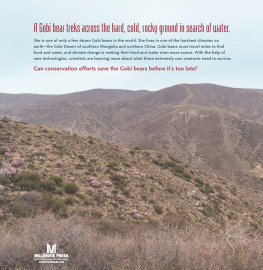
Sandra Markle
Little Lost Bat
Illustrated by
Alan Marks
With love for my mother, Dorothy HaldemanS. M.
To Preston Primary SchoolA. M.
Acknowledgments
Sandra Markle would like to thank Barbara French, Bat Conservation
International, and Amanda Lollar, founder and president of Bat World
Sanctuary, for sharing their expertise and enthusiasm. A special thank you
to Skip Jeffery for his loving support throughout the creative process.
2009 First paperback edition
Text copyright 2006 by Sandra Markle
Illustrations copyright 2006 by Alan Marks
All rights reserved, including the right of reproduction in whole or in part in any form.
Charlesbridge and colophon are registered trademarks of Charlesbridge Publishing, Inc.
Published by Charlesbridge
85 Main Street
Watertown, MA 02472
(617) 926-0329
www.charlesbridge.com
Library of Congress Cataloging-in-Publication Data
Markle, Sandra.
Little lost bat / Sandra Markle ; illustrated by Alan Marks.
p. cm.
Summary: Chronicles the early life of an orphaned Mexican free-tailed
bat, from its birth to its adoption by a new mother. Includes back matter
about batsProvided by publisher.
ISBN: 978-1-57091-656-4 (reinforced for library use)
ISBN: 978-1-57091-657-1 (soft cover)
1. Tadarida brasiliensisInfancyJuvenile literature. I. Marks, Alan, 1957 ill. II. Title.
QL737.C54M37 2006 ISBN-13: 978-1-68444-656-8 (e-book)
599.4'9dc22 2005019619
Printed in China
(hc) 10 9 8 7 6 5 4
(sc) 10 9 8 7 6 5 4 3 2 1
Illustrations done in watercolor, pen, and pencil on Daler Bloxworth paper
Display type and text type set in Elroy and Fairfield
Color separations by Chroma Graphics, Singapore
Printed and bound by Jade Productions
Production supervision by Brian G. Walker
Designed by Susan Mallory Sherman
Synchred Read-Along Version by:
Triangle Interactive LLC
PO Box 573
Prior Lake, MN 55372

Its a warm June day in central Texas.
And high on the domed roof of Bracken Cave
so far from the cave mouth that its almost
too dark for shadows
one little female Mexican free-tailed bat
clings tightly to the ceiling
with her toes and wing claws
poked into cracks.
Then she curls her body into a hammock shape.
Its time for her baby to be born.

Even though the rock cave is as huge
as a cathedral, its steamy hot
from the body heat of
millions of female bats
packed close together.
And its shockingly
noisy
from so many bat voices.
The sounds are made even louder by echoes
bouncing
off the caves walls, ceiling, and floor.
Yet all the while she labors,
the little female calls,
CH-CH-CH!
CH-CH-CH!
CH-CH-CH!
No matter that its noisy all around her.
Shes only calling to one listener,
her baby.

And the instant hes born
naked-pink and tiny as a peanut in its shell
she folds up her tail membrane to keep him from falling
down,
down,
down
to the waiting, hungry beetles
on the cave floor.
Then the little bat,
nudged by his mother,
crawls up onto her chest,
clinging to her fur
with tiny hooked claws.
There he finds a nipple,
and, tucked beneath her wing,
he nurses.

During the day, the little bats mother
is only as far away as her roost.
She rests among all of the other mothers.
And she flies back a few times a day to her little bat
to let him nurse.
The babies huddle together
and wait for their mothers to return.
A snake lurking at the entrance
crawls across the cave ceiling
and snags a baby bat for dinner.
Still, there is safety among such great numbers.

But as the day ends,
some inner sense lets the mother know its time
to leave the cave and hunt.
With no partner to help her,
she has to feed herself
as well as her baby.
So the mother bat
joins the millions of female bats
racing out of the cave.

The cloud of bats
explodes into the twilight
like dark fireworks.
Hawks hunting in the sky catch a few of the mothers.

The females, forced to spread out to start hunting,
zip this way and that.
Each nursing mother needs to eat
nearly her weight in insects
before the night is through.

Flapping hard,
the little bats mother shoots bursts
of high-pitched sounds from her mouth.
And she listens
with big ears, turning to catch the echoes
bouncing back.
Analyzing these in a flash,
she homes in on a moth.

Slap! She sweeps her prey
toward her body with a wing stroke.
Next, she scoops it up,
using her tail membrane like a catchers mitt,




























